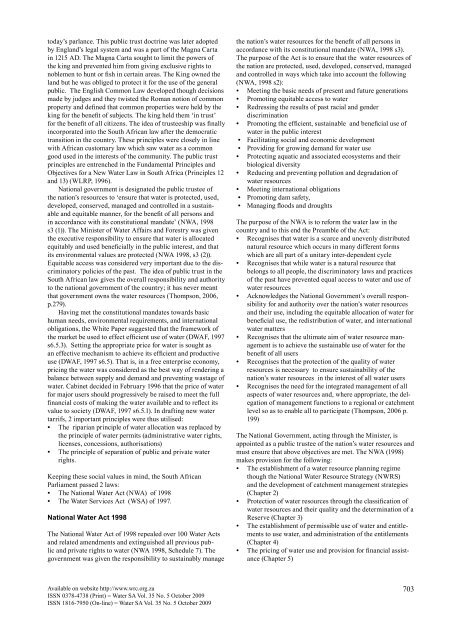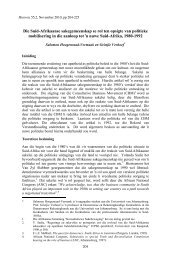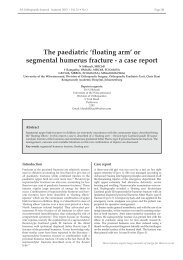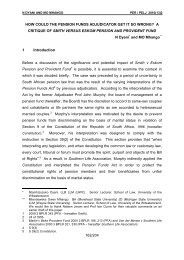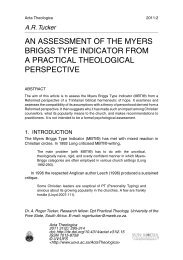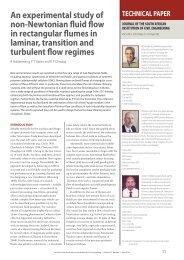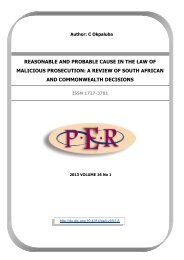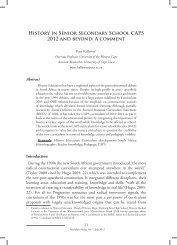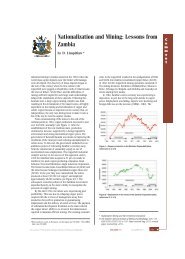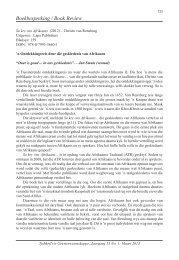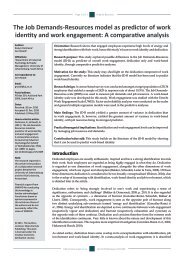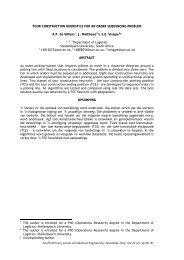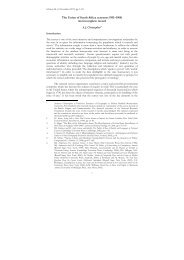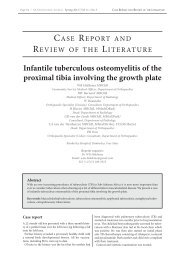A detailed analysis of evolution of water rights in South Africa: An ...
A detailed analysis of evolution of water rights in South Africa: An ...
A detailed analysis of evolution of water rights in South Africa: An ...
You also want an ePaper? Increase the reach of your titles
YUMPU automatically turns print PDFs into web optimized ePapers that Google loves.
today’s parlance. This public trust doctr<strong>in</strong>e was later adopted<br />
by England’s legal system and was a part <strong>of</strong> the Magna Carta<br />
<strong>in</strong> 1215 AD. The Magna Carta sought to limit the powers <strong>of</strong><br />
the k<strong>in</strong>g and prevented him from giv<strong>in</strong>g exclusive <strong>rights</strong> to<br />
noblemen to hunt or fish <strong>in</strong> certa<strong>in</strong> areas. The K<strong>in</strong>g owned the<br />
land but he was obliged to protect it for the use <strong>of</strong> the general<br />
public. The English Common Law developed though decisions<br />
made by judges and they twisted the Roman notion <strong>of</strong> common<br />
property and def<strong>in</strong>ed that common properties were held by the<br />
k<strong>in</strong>g for the benefit <strong>of</strong> subjects. The k<strong>in</strong>g held them ‘<strong>in</strong> trust’<br />
for the benefit <strong>of</strong> all citizens. The idea <strong>of</strong> trusteeship was f<strong>in</strong>ally<br />
<strong>in</strong>corporated <strong>in</strong>to the <strong>South</strong> <strong>Africa</strong>n law after the democratic<br />
transition <strong>in</strong> the country. These pr<strong>in</strong>ciples were closely <strong>in</strong> l<strong>in</strong>e<br />
with <strong>Africa</strong>n customary law which saw <strong>water</strong> as a common<br />
good used <strong>in</strong> the <strong>in</strong>terests <strong>of</strong> the community. The public trust<br />
pr<strong>in</strong>ciples are entrenched <strong>in</strong> the Fundamental Pr<strong>in</strong>ciples and<br />
Objectives for a New Water Law <strong>in</strong> <strong>South</strong> <strong>Africa</strong> (Pr<strong>in</strong>ciples 12<br />
and 13) (WLRP, 1996).<br />
National government is designated the public trustee <strong>of</strong><br />
the nation’s resources to ‘ensure that <strong>water</strong> is protected, used,<br />
developed, conserved, managed and controlled <strong>in</strong> a susta<strong>in</strong>able<br />
and equitable manner, for the benefit <strong>of</strong> all persons and<br />
<strong>in</strong> accordance with its constitutional mandate’ (NWA, 1998<br />
s3 (1)). The M<strong>in</strong>ister <strong>of</strong> Water Affairs and Forestry was given<br />
the executive responsibility to ensure that <strong>water</strong> is allocated<br />
equitably and used beneficially <strong>in</strong> the public <strong>in</strong>terest, and that<br />
its environmental values are protected (NWA 1998, s3 (2)).<br />
Equitable access was considered very important due to the discrim<strong>in</strong>atory<br />
policies <strong>of</strong> the past. The idea <strong>of</strong> public trust <strong>in</strong> the<br />
<strong>South</strong> <strong>Africa</strong>n law gives the overall responsibility and authority<br />
to the national government <strong>of</strong> the country; it has never meant<br />
that government owns the <strong>water</strong> resources (Thompson, 2006,<br />
p.279).<br />
Hav<strong>in</strong>g met the constitutional mandates towards basic<br />
human needs, environmental requirements, and <strong>in</strong>ternational<br />
obligations, the White Paper suggested that the framework <strong>of</strong><br />
the market be used to effect efficient use <strong>of</strong> <strong>water</strong> (DWAF, 1997<br />
s6.5.3). Sett<strong>in</strong>g the appropriate price for <strong>water</strong> is sought as<br />
an effective mechanism to achieve its efficient and productive<br />
use (DWAF, 1997 s6.5). That is, <strong>in</strong> a free enterprise economy,<br />
pric<strong>in</strong>g the <strong>water</strong> was considered as the best way <strong>of</strong> render<strong>in</strong>g a<br />
balance between supply and demand and prevent<strong>in</strong>g wastage <strong>of</strong><br />
<strong>water</strong>. Cab<strong>in</strong>et decided <strong>in</strong> February 1996 that the price <strong>of</strong> <strong>water</strong><br />
for major users should progressively be raised to meet the full<br />
f<strong>in</strong>ancial costs <strong>of</strong> mak<strong>in</strong>g the <strong>water</strong> available and to reflect its<br />
value to society (DWAF, 1997 s6.5.1). In draft<strong>in</strong>g new <strong>water</strong><br />
tarrifs, 2 important pr<strong>in</strong>ciples were thus utilised:<br />
• The riparian pr<strong>in</strong>ciple <strong>of</strong> <strong>water</strong> allocation was replaced by<br />
the pr<strong>in</strong>ciple <strong>of</strong> <strong>water</strong> permits (adm<strong>in</strong>istrative <strong>water</strong> <strong>rights</strong>,<br />
licenses, concessions, authorisations)<br />
• The pr<strong>in</strong>ciple <strong>of</strong> separation <strong>of</strong> public and private <strong>water</strong><br />
<strong>rights</strong>.<br />
Keep<strong>in</strong>g these social values <strong>in</strong> m<strong>in</strong>d, the <strong>South</strong> <strong>Africa</strong>n<br />
Parliament passed 2 laws:<br />
• The National Water Act (NWA) <strong>of</strong> 1998<br />
• The Water Services Act (WSA) <strong>of</strong> 1997.<br />
National Water Act 1998<br />
The National Water Act <strong>of</strong> 1998 repealed over 100 Water Acts<br />
and related amendments and ext<strong>in</strong>guished all previous public<br />
and private <strong>rights</strong> to <strong>water</strong> (NWA 1998, Schedule 7). The<br />
government was given the responsibility to susta<strong>in</strong>ably manage<br />
the nation’s <strong>water</strong> resources for the benefit <strong>of</strong> all persons <strong>in</strong><br />
accordance with its constitutional mandate (NWA, 1998 s3).<br />
The purpose <strong>of</strong> the Act is to ensure that the <strong>water</strong> resources <strong>of</strong><br />
the nation are protected, used, developed, conserved, managed<br />
and controlled <strong>in</strong> ways which take <strong>in</strong>to account the follow<strong>in</strong>g<br />
(NWA, 1998 s2):<br />
• Meet<strong>in</strong>g the basic needs <strong>of</strong> present and future generations<br />
• Promot<strong>in</strong>g equitable access to <strong>water</strong><br />
• Redress<strong>in</strong>g the results <strong>of</strong> past racial and gender<br />
discrim<strong>in</strong>ation<br />
• Promot<strong>in</strong>g the efficient, susta<strong>in</strong>able and beneficial use <strong>of</strong><br />
<strong>water</strong> <strong>in</strong> the public <strong>in</strong>terest<br />
• Facilitat<strong>in</strong>g social and economic development<br />
• Provid<strong>in</strong>g for grow<strong>in</strong>g demand for <strong>water</strong> use<br />
• Protect<strong>in</strong>g aquatic and associated ecosystems and their<br />
biological diversity<br />
• Reduc<strong>in</strong>g and prevent<strong>in</strong>g pollution and degradation <strong>of</strong><br />
<strong>water</strong> resources<br />
• Meet<strong>in</strong>g <strong>in</strong>ternational obligations<br />
• Promot<strong>in</strong>g dam safety,<br />
• Manag<strong>in</strong>g floods and droughts<br />
The purpose <strong>of</strong> the NWA is to reform the <strong>water</strong> law <strong>in</strong> the<br />
country and to this end the Preamble <strong>of</strong> the Act:<br />
• Recognises that <strong>water</strong> is a scarce and unevenly distributed<br />
natural resource which occurs <strong>in</strong> many different forms<br />
which are all part <strong>of</strong> a unitary <strong>in</strong>ter-dependent cycle<br />
• Recognises that while <strong>water</strong> is a natural resource that<br />
belongs to all people, the discrim<strong>in</strong>atory laws and practices<br />
<strong>of</strong> the past have prevented equal access to <strong>water</strong> and use <strong>of</strong><br />
<strong>water</strong> resources<br />
• Acknowledges the National Government’s overall responsibility<br />
for and authority over the nation’s <strong>water</strong> resources<br />
and their use, <strong>in</strong>clud<strong>in</strong>g the equitable allocation <strong>of</strong> <strong>water</strong> for<br />
beneficial use, the redistribution <strong>of</strong> <strong>water</strong>, and <strong>in</strong>ternational<br />
<strong>water</strong> matters<br />
• Recognises that the ultimate aim <strong>of</strong> <strong>water</strong> resource management<br />
is to achieve the susta<strong>in</strong>able use <strong>of</strong> <strong>water</strong> for the<br />
benefit <strong>of</strong> all users<br />
• Recognises that the protection <strong>of</strong> the quality <strong>of</strong> <strong>water</strong><br />
resources is necessary to ensure susta<strong>in</strong>ability <strong>of</strong> the<br />
nation’s <strong>water</strong> resources <strong>in</strong> the <strong>in</strong>terest <strong>of</strong> all <strong>water</strong> users<br />
• Recognises the need for the <strong>in</strong>tegrated management <strong>of</strong> all<br />
aspects <strong>of</strong> <strong>water</strong> resources and, where appropriate, the delegation<br />
<strong>of</strong> management functions to a regional or catchment<br />
level so as to enable all to participate (Thompson, 2006 p.<br />
199)<br />
The National Government, act<strong>in</strong>g through the M<strong>in</strong>ister, is<br />
appo<strong>in</strong>ted as a public trustee <strong>of</strong> the nation’s <strong>water</strong> resources and<br />
must ensure that above objectives are met. The NWA (1998)<br />
makes provision for the follow<strong>in</strong>g:<br />
• The establishment <strong>of</strong> a <strong>water</strong> resource plann<strong>in</strong>g regime<br />
though the National Water Resource Strategy (NWRS)<br />
and the development <strong>of</strong> catchment management strategies<br />
(Chapter 2)<br />
• Protection <strong>of</strong> <strong>water</strong> resources through the classification <strong>of</strong><br />
<strong>water</strong> resources and their quality and the determ<strong>in</strong>ation <strong>of</strong> a<br />
Reserve (Chapter 3)<br />
• The establishment <strong>of</strong> permissible use <strong>of</strong> <strong>water</strong> and entitlements<br />
to use <strong>water</strong>, and adm<strong>in</strong>istration <strong>of</strong> the entitlements<br />
(Chapter 4)<br />
• The pric<strong>in</strong>g <strong>of</strong> <strong>water</strong> use and provision for f<strong>in</strong>ancial assistance<br />
(Chapter 5)<br />
Available on website http://www.wrc.org.za<br />
ISSN 0378-4738 (Pr<strong>in</strong>t) = Water SA Vol. 35 No. 5 October 2009<br />
ISSN 1816-7950 (On-l<strong>in</strong>e) = Water SA Vol. 35 No. 5 October 2009<br />
703


